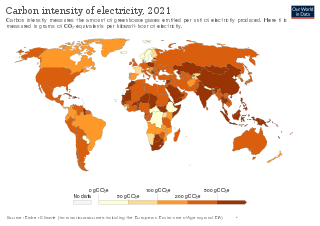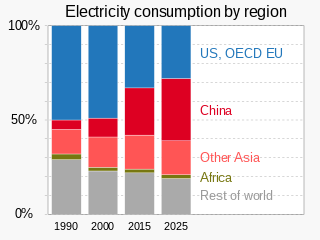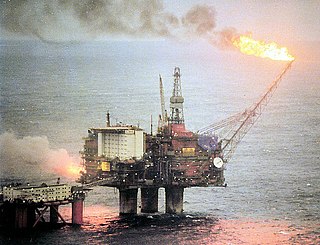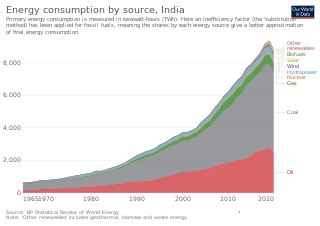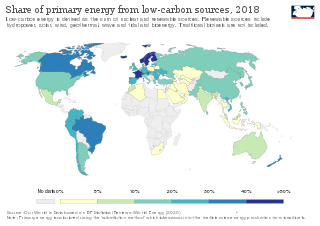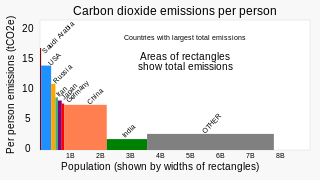List
Data are from IRENA unless otherwise specified, and are for the year 2021. [1]
| Country / dependency | % ren. | Ren. gen. (GWh) | % hydro | % wind | % solar | % bio. | % geo. |
|---|---|---|---|---|---|---|---|
| 100% | 15,817 | 94.5% | 5.2% | 0.2% | 0.1% | 0% | |
| 100% | 10,823 | 100% | 0% | 0% | 0% | 0% | |
| 100% | 8,963 | 99.5% | 0% | 0.5% | 0% | 0% | |
| 100% | 0.8 | 98.7% | 1.3% | 0% | 0% | 0% | |
| 100% | 8,107 | 98.7% | 0% | 1.2% | 0.1% | 0% | |
| 100% | 40,848 | 99.3% | 0% | 0% | 0.7% | 0% | |
| 100% | 19,617 | 70.4% | 0.03% | 0.03% | 0% | 29.6% | |
| 100% | 12,656 | 73.4% | 12.4% | 0.8% | 0.7% | 12.7% | |
| 99.8% | 532 | 99.6% | 0% | 0.1% | 0% | 0% | |
| 99.8% | 460 | 56.1% | 0% | 0.3% | 43.4% | 0% | |
| 99.1% | 156,507 | 91.4% | 7.5% | 0.1% | 0.02% | 0% | |
| 99.0% | 11,921 | 98.8% | 0% | 0.2% | 0.1% | 0% | |
| 97.8% | 4,749 | 88.2% | 0% | 2.9% | 6.8% | 0% | |
| 96.5% | 142 | 96.2% | 0% | 0.3% | 0% | 0% | |
| 93.3% | 97 | 75.9% | 0% | 1.2% | 0% | 0% | |
| 92.9% | 437 | 33.4% | 0.01% | 2.1% | 57.4% | 0% | |
| 92.8% | 19,348 | 92.8% | 0% | 0% | 0% | 0% | |
| 92.0% | 16,310 | 90.7% | 0% | 0.9% | 0.4% | 0% | |
| 91.7% | 1.2 | 0% | 0% | 91.7% | 0% | 0% | |
| 90.7% | 1,333 | 59.5% | 1.5% | 29.7% | 0.01% | 0% | |
| 89.0% | 1,968 | 49.1% | 14.2% | 8.1% | 15.7% | 0% | |
| 88.1% | 2,667 | 87.4% | 0% | 0.7% | 0% | 0% | |
| 88.1% | 9,663 | 34.5% | 0.8% | 3.9% | 1.8% | 47.3% | |
| 86.0% | 6,063 | 25.9% | 1.9% | 23.3% | 12.8% | 22.1% | |
| 85.6% | 12,957 | 85.6% | 0% | 0% | 0% | 0% | |
| 84.5% | 13,492 | 33.0% | 31.3% | 3.0% | 17.2% | 0% | |
| 84.5% | 15,603 | 83.8% | 0% | 0.4% | 0.3% | 0% | |
| 84.2% | 62,614 | 84.1% | 0.1% | 0.01% | 0% | 0% | |
| 81.7% | 9,597 | 69.4% | 4.5% | 5.6% | 2.2% | 0% | |
| 81.4% | 36,329 | 54.3% | 5.9% | 0.5% | 1.8% | 18.9% | |
| 81.2% | 10,289 | 80.4% | 0.7% | 0.2% | 0% | 0% | |
| 81.0% | 26,077 | 79.4% | 0.2% | 0.1% | 1.3% | 0% | |
| 80.1% | 1,869 | 72.5% | 0% | 5.5% | 2.1% | 0% | |
| 79.9% | 56,542 | 60.1% | 9.5% | 3.9% | 5.8% | 0% | |
| 79.3% | 5,110 | 79.0% | 0% | 0.3% | 0% | 0% | |
| 79.0% | 26,096 | 0.05% | 48.6% | 4.0% | 23.4% | 0% | |
| 78.2% | 927 | 71.7% | 0.01% | 6.6% | 0% | 0% | |
| 77.4% | 507,667 | 55.3% | 11.0% | 2.6% | 8.5% | 0% | |
| 77.0% | 447 | 74.5% | 0.01% | 0.1% | 0% | 0% | |
| 75.4% | 63,145 | 72.5% | 0.1% | 0.6% | 2.2% | 0% | |
| 75.3% | 244 | 70.5% | 0% | 1.9% | 2.9% | 0% | |
| 73.7% | 14,004 | 72.6% | 0% | 0.01% | 1.1% | 0% | |
| 73.3% | 9,393 | 46.5% | 2.5% | 1.9% | 20.3% | 2.1% | |
| 71.3% | 6,217 | 68.9% | 0% | 0.7% | 1.6% | 0% | |
| 69.9% | 10,629 | 47.5% | 13.6% | 1.0% | 7.2% | 0.6% | |
| 69.3% | 28,427 | 69.1% | 0% | 0.1% | 0.1% | 0% | |
| 69.3% | 2,928 | 14.2% | 15.5% | 0.6% | 21.6% | 17.4% | |
| 69.1% | 688 | 58.8% | 0% | 5.7% | 4.6% | 0% | |
| 68.1% | 44,949 | 60.4% | 0.2% | 4.3% | 1.5% | 0% | |
| 67.5% | 433,791 | 59.5% | 5.4% | 0.9% | 1.5% | 0% | |
| 67.4% | 115,778 | 43.0% | 15.9% | 0.9% | 6.6% | 0% | |
| 65.6% | 3,332 | 21.5% | 26.8% | 3.8% | 10.7% | 0% | |
| 64.9% | 33,089 | 26.4% | 25.9% | 4.4% | 7.2% | 0.4% | |
| 63.6% | 3,718 | 46.3% | 2.4% | 0.1% | 14.7% | 0% | |
| 63.2% | 16,168 | 63.0% | 0% | 0.3% | 0% | 0% | |
| 62.8% | 7,186 | 33.0% | 6.8% | 9.5% | 10.5% | 3.0% | |
| 62.3% | 1,875 | 56.6% | 0% | 3.1% | 2.6% | 0% | |
| 61.8% | 2,333 | 53.2% | 8.5% | 0.1% | 0% | 0% | |
| 61.7% | 35,203 | 55.9% | 3.2% | 1.5% | 1.0% | 0% | |
| 61.3% | 278 | 59.6% | 0% | 0.5% | 1.2% | 0% | |
| 60.8% | 10,195 | 60.0% | 0% | 0.2% | 0.6% | 0% | |
| 60.1% | 657 | 50.1% | 0.03% | 1.1% | 8.8% | 0% | |
| 58.9% | 5,757 | 51.6% | 0% | 6.5% | 0.8% | 0% | |
| 58.2% | 595 | 54.5% | 0% | 3.5% | 0.2% | 0% | |
| 57.4% | 132 | 55.7% | 0% | 1.6% | 0.1% | 0% | |
| 54.0% | 984 | 53.9% | 0% | 0.04% | 0.1% | 0% | |
| 53.9% | 866 | 52.7% | 0% | 0.8% | 0.4% | 0% | |
| 52.9% | 38,174 | 21.9% | 11.8% | 0.4% | 18.0% | 0% | |
| 51.2% | 8,580 | 43.0% | 3.8% | 3.3% | 1.0% | 0% | |
| 49.1% | 80 | 28.8% | 0.1% | 14.1% | 6.1% | 0% | |
| 48.9% | 42,321 | 20.9% | 8.8% | 12.3% | 6.5% | 0.4% | |
| 47.0% | 128,968 | 12.0% | 22.6% | 9.9% | 2.2% | 0% | |
| 46.4% | 12,234 | 45.1% | 0% | 0.3% | 1.0% | 0% | |
| 44.9% | 26,677 | 29.8% | 11.1% | 2.9% | 1.1% | 0% | |
| 42.8% | 857 | 40.0% | 0.02% | 2.8% | 0.03% | 0% | |
| 42.8% | 104,331 | 31.1% | 1.0% | 10.5% | 0.1% | 0% | |
| 42.8% | 3,407 | 40.4% | 0.1% | 0.3% | 2.0% | 0% | |
| 41.0% | 118,442 | 16.4% | 7.2% | 8.7% | 5.8% | 2.0% | |
| 40.7% | 1,078 | 39.5% | 0% | 0.03% | 1.2% | 0% | |
| 40.6% | 22,195 | 10.9% | 19.2% | 9.6% | 0.9% | 0% | |
| 40.4% | 124,072 | 2.4% | 21.0% | 3.9% | 11.5% | 0% | |
| 40.1% | 236,115 | 4.2% | 19.5% | 8.4% | 7.0% | 0.04% | |
| 40.0% | 1,145 | 35.3% | 0% | 0.2% | 1.1% | 3.4% | |
| 40.0% | 2,879 | 0.3% | 10.2% | 4.9% | 23.7% | 0% | |
| 39.3% | 7,292 | 36.7% | 2.1% | 0.4% | 0.2% | 0% | |
| 38.3% | 4,162 | 29.8% | 1.1% | 3.2% | 4.2% | 0% | |
| 38.1% | 161 | 23.7% | 12.8% | 0.04% | 1.6% | 0% | |
| 37.3% | 11,900 | 3.2% | 30.7% | 0.3% | 2.0% | 0% | |
| 36.1% | 5,733 | 31.5% | 0.04% | 2.9% | 1.7% | 0% | |
| 35.4% | 118,555 | 16.7% | 9.4% | 4.2% | 1.8% | 3.2% | |
| 35.4% | 70 | 0% | 35.1% | 0.3% | 0% | 0% | |
| 34.9% | 13,375 | 31.3% | 2.8% | 0.2% | 0.6% | 0% | |
| 34.8% | 7,690 | 34.0% | 0% | 0.7% | 0.1% | 0% | |
| 33.8% | 563 | 0.7% | 6.4% | 6.8% | 14.9% | 5.0% | |
| 33.1% | 40,472 | 0.1% | 14.7% | 9.4% | 7.1% | 0% | |
| 30.7% | 1,713 | 26.0% | 1.9% | 1.9% | 1.0% | 0% | |
| 30.5% | 2,367 | 28.4% | 0.02% | 2.1% | 0% | 0% | |
| 29.8% | 45,183 | 24.7% | 2.3% | 0.8% | 2.0% | 0% | |
| 28.6% | 2,444,538 | 15.7% | 7.7% | 3.8% | 0.9% | 0% | |
| 28.2% | 872 | 11.6% | 0.1% | 8.7% | 7.8% | 0% | |
| World | 28.1% | 7,983,492 | 15.5% | 6.5% | 3.6% | 1.9% | 0.3% |
| 27.4% | 234 | 15.8% | 0% | 11.4% | 0.2% | 0% | |
| 27.2% | 39,116 | 14.0% | 9.0% | 1.5% | 2.7% | 0% | |
| 26.7% | 70,799 | 5.7% | 9.2% | 10.4% | 1.3% | 0% | |
| 26.0% | 393 | 0% | 3.2% | 6.0% | 16.4% | 0% | |
| 25.3% | 9,318 | 24.9% | 0% | 0.3% | 0.2% | 0% | |
| 25.2% | 20 | 10.7% | 5.2% | 9.2% | 0% | 0% | |
| 24.5% | 224 | 0% | 0% | 24.4% | 0.03% | 0% | |
| 24.2% | 5,325 | 0.1% | 7.2% | 16.9% | 0.02% | 0% | |
| 24.1% | 38 | 0% | 18.4% | 5.7% | 0% | 0% | |
| 23.9% | 4 | 0% | 23.2% | 0.7% | 0% | 0% | |
| 23.7% | 148 | 23.1% | 0.01% | 0.6% | 0% | 0% | |
| 23.6% | 7,072 | 15.2% | 0.02% | 2.2% | 6.0% | 0% | |
| 23.5% | 23,656 | 1.3% | 11.9% | 5.6% | 3.7% | 0% | |
| 22.8% | 126,708 | 11.5% | 6.6% | 2.8% | 1.3% | 0.02% | |
| 22.5% | 654 | 14.6% | 1.4% | 6.4% | 0.02% | 0% | |
| 22.2% | 10,556 | 10.7% | 3.0% | 3.1% | 5.4% | 0% | |
| 22.0% | 24,023 | 8.5% | 1.2% | 1.4% | 1.2% | 9.8% | |
| 21.6% | 649 | 3.6% | 0.5% | 5.2% | 12.3% | 0% | |
| 21.1% | 7 | 0% | 0% | 21.1% | 0% | 0% | |
| 21.1% | 221,529 | 8.5% | 0.9% | 8.2% | 3.1% | 0.3% | |
| 21.1% | 81,902 | 8.9% | 5.4% | 5.2% | 0.4% | 1.1% | |
| 20.8% | 848 | 0% | 9.8% | 9.3% | 1.6% | 0% | |
| 20.7% | 158 | 11.2% | 0% | 9.5% | 0% | 0% | |
| 20.4% | 222,080 | 19.9% | 0.3% | 0.1% | 0.04% | 0.04% | |
| 20.3% | 21 | 19.5% | 0.6% | 0.2% | 0% | 0% | |
| 20.3% | 886,892 | 6.3% | 8.8% | 3.5% | 1.2% | 0.4% | |
| 19.9% | 8,222 | 2.9% | 12.4% | 4.5% | 0.1% | 0% | |
| 19.5% | 155 | 0% | 17.7% | 1.8% | 0% | 0% | |
| 19.4% | 271 | 0% | 9.4% | 10.0% | 0% | 0% | |
| 19.2% | 313,073 | 9.9% | 3.8% | 4.0% | 1.3% | 0% | |
| 19.1% | 6,915 | 0.6% | 1.8% | 10.5% | 5.7% | 0.03% | |
| 19.0% | 35,467 | 2.6% | 1.9% | 2.7% | 11.2% | 0% | |
| 18.7% | 2,633 | 18.7% | 0% | 0.04% | 0% | 0% | |
| 18.3% | 81 | 0% | 16.7% | 1.6% | 0% | 0% | |
| 18.2% | 205 | 17.8% | 0.01% | 0.4% | 0% | 0% | |
| 18.1% | 55,767 | 8.0% | 0% | 0.1% | 4.9% | 5.2% | |
| 17.8% | 30,597 | 15.9% | 0% | 0.3% | 1.7% | 0% | |
| 17.5% | 31,364 | 1.7% | 9.0% | 2.2% | 4.3% | 0% | |
| 17.0% | 3,962 | 6.4% | 5.3% | 3.8% | 1.5% | 0% | |
| 16.9% | 497 | 0% | 0% | 16.9% | 0% | 0% | |
| 16.4% | 5 | 0% | 0% | 16.4% | 0% | 0% | |
| 15.8% | 2 | 0% | 0% | 15.8% | 0% | 0% | |
| 15.1% | 775 | 0% | 4.8% | 9.1% | 1.2% | 0% | |
| 15.0% | 22 | 13.4% | 0% | 1.6% | 0% | 0% | |
| 14.8% | 157 | 0% | 12.5% | 2.3% | 0% | 0% | |
| 14.2% | 10 | 0% | 3.6% | 10.6% | 0% | 0% | |
| 14.0% | 11,922 | 4.3% | 0.7% | 2.7% | 6.2% | 0% | |
| 13.9% | 0.5 | 0% | 0% | 13.9% | 0% | 0% | |
| 12.8% | 551 | 3.2% | 6.1% | 3.1% | 0.4% | 0% | |
| 12.7% | 18,971 | 5.0% | 2.3% | 4.8% | 0.5% | 0% | |
| 12.3% | 25,288 | 7.2% | 2.6% | 2.4% | 0.1% | 0% | |
| 12.1% | 44 | 0% | 0% | 12.1% | 0% | 0% | |
| 12.0% | 127 | 11.9% | 0% | 0.02% | 0% | 0% | |
| 11.9% | 263 | 0% | 0% | 11.6% | 0.3% | 0% | |
| 11.2% | 43 | 0% | 1.6% | 9.6% | 0% | 0% | |
| 11.0% | 12,656 | 8.0% | 1.5% | 1.4% | 0.03% | 0% | |
| 10.3% | 2 | 0% | 0% | 10.3% | 0% | 0% | |
| 10.3% | 814 | 1.1% | 7.1% | 2.1% | 0% | 0% | |
| 9.8% | 5 | 0% | 0% | 9.8% | 0% | 0% | |
| 9.5% | 433 | 6.8% | 1.7% | 0.2% | 0.7% | 0% | |
| 8.1% | 46 | 0% | 0% | 8.1% | 0% | 0% | |
| 7.7% | 5,050 | 7.7% | 0% | 0.1% | 0% | 0% | |
| 7.6% | 5,631 | 0% | 0.2% | 7.2% | 0.1% | 0% | |
| 7.4% | 15,783 | 3.1% | 0.1% | 4.0% | 0.2% | 0% | |
| 7.3% | 88 | 0% | 0% | 7.3% | 0% | 0% | |
| 7.1% | 86 | 0.001% | 0.03% | 1.1% | 6.0% | 0% | |
| 7.1% | 2 | 0% | 0% | 7.1% | 0% | 0% | |
| 6.7% | 41,275 | 1.1% | 0.5% | 3.8% | 1.2% | 0% | |
| 6.6% | 7 | 0.9% | 0% | 3.0% | 2.7% | 0% | |
| 6.5% | 18,802 | 2.3% | 0.8% | 2.7% | 0.1% | 0% | |
| 6.4% | 439 | 4.3% | 1.8% | 0.2% | 0% | 0% | |
| 6.1% | 6 | 5.9% | 0% | 0.2% | 0% | 0% | |
| 5.8% | 49 | 0% | 0.3% | 5.5% | 0% | 0% | |
| 5.8% | 1,617 | 4.6% | 0.3% | 0.2% | 0% | 0% | |
| 5.7% | 20 | 0% | 0% | 5.7% | 0% | 0% | |
| 5.6% | 19 | 0% | 2.6% | 0.4% | 2.6% | 0% | |
| 5.3% | 4,541 | 4.8% | 0% | 0.4% | 0% | 0% | |
| 5.1% | 926 | 0.7% | 0.2% | 1.2% | 3.0% | 0% | |
| 5.0% | 22 | 0% | 0.3% | 4.7% | 0% | 0% | |
| 4.9% | 4 | 1.4% | 0% | 3.5% | 0% | 0% | |
| 4.8% | 84 | 0% | 0.03% | 4.8% | 0% | 0% | |
| 4.6% | 4 | 0% | 0% | 4.6% | 0% | 0% | |
| 4.6% | 898 | 0.2% | 0.8% | 3.5% | 0.1% | 0% | |
| 4.5% | 10 | 0% | 2.4% | 2.1% | 0% | 0% | |
| 4.5% | 20 | 0% | 1.1% | 3.4% | 0% | 0% | |
| 4.2% | 15,084 | 3.9% | 0.2% | 0.2% | 0.01% | 0% | |
| 4.2% | 6,262 | 0% | 0% | 4.2% | 0.0% | 0% | |
| 4.1% | 2,267 | 0% | 0% | 0.9% | 0.8% | 0% | |
| 3.9% | 7 | 0% | 0% | 3.9% | 0% | 0% | |
| 3.5% | 523 | 2.5% | 0% | 0.7% | 0.2% | 0% | |
| 3.4% | 1,298 | 1.0% | 0.4% | 0.5% | 1.5% | 0% | |
| 3.3% | 847 | 2.9% | 0% | 0.2% | 0.1% | 0% | |
| 2.9% | 22 | 0% | 0% | 2.9% | 0% | 0% | |
| 2.9% | 617 | 0.1% | 2.0% | 0.8% | 0% | 0% | |
| 2.5% | 10 | 0% | 0% | 1.9% | 0.7% | 0% | |
| 2.5% | 17 | 0% | 0.04% | 2.5% | 0% | 0% | |
| 2.5% | 3 | 0% | 0% | 2.5% | 0% | 0% | |
| 2.4% | 2 | 0% | 0.02% | 2.4% | 0% | 0% | |
| 2.3% | 4 | 0% | 1.2% | 1.1% | 0% | 0% | |
| 2.0% | 5 | 0% | 0.1% | 1.9% | 0% | 0% | |
| 1.9% | 802 | 0% | 0.3% | 1.6% | 0% | 0% | |
| 1.6% | 6 | 0% | 0.5% | 1.1% | 0% | 0% | |
| 1.6% | 1,436 | 0.8% | 0.01% | 0.8% | 0.0% | 0% | |
| 1.5% | 4 | 0% | 0% | 1.5% | 0% | 0% | |
| 0.9% | 780 | 0.01% | 0.01% | 0.9% | 0% | 0% | |
| 0.8% | 311 | 0.004% | 0% | 0.3% | 0.5% | 0% | |
| 0.8% | 1.5 | 0% | 0% | 0.8% | 0% | 0% | |
| 0.5% | 8 | 0% | 0.04% | 0.4% | 0% | 0% | |
| 0.4% | 2 | 0.3% | 0% | 0.1% | 0% | 0% | |
| 0.3% | 2 | 0% | 0% | 0.3% | 0% | 0% | |
| 0.3% | 143 | 0% | 0% | 0.02% | 0.1% | 0% | |
| 0.3% | 214 | 0% | 0.1% | 0.2% | 0% | 0% | |
| 0.2% | 6 | 0% | 0% | 0.2% | 0% | 0% | |
| 0.2% | 3 | 0.01% | 0% | 0.2% | 0% | 0% | |
| 0.1% | 6 | 0% | 0% | 0.1% | 0% | 0% | |
| 0.1% | 267 | 0% | 0% | 0.1% | 0% | 0% | |
| 0.1% | 0.07 | 0% | 0% | 0.1% | 0% | 0% | |
| 0.04% | 13 | 0% | 0% | 0.03% | 0% | 0% | |
| 0.03% | 1.1 | 0% | 0% | 0.03% | 0% | 0% | |
| 0.02% | 8 | 0% | 0% | 0.02% | 0% | 0% | |
| 0.01% | 3 | 0.01% | 0% | 0% | 0% | 0% | |
| 0% | 0 | 0% | 0% | 0% | 0% | 0% | |
| 0% | 0 | 0% | 0% | 0% | 0% | 0% | |
| 0% | 0 | 0% | 0% | 0% | 0% | 0% |


